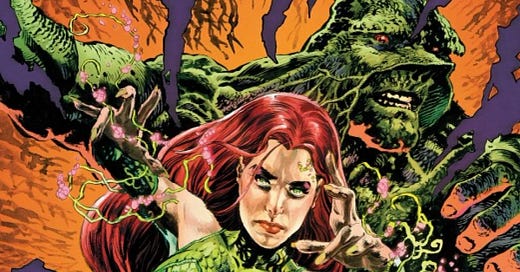Jason Bateman Isn’t Batman—But Poison Ivy Is Still Iconic
My accidental comic book awakening, brought to you by Poison Ivy, my dad, and State Farm
Last December, I spontaneously agreed to accompany my dad to a comic book store, on the condition that he’d buy me ice cream afterward. We had just finished binging Christopher Nolan’s Dark Knight trilogy, and while I definitely wanted ice cream—and to spend time with my dad, of course—I was also newly curious about the world of DC. I had thoroughly enjoyed Matt Reeve’s The Batman featuring Robert Pattinson, and The Penguin had just aired its season finale on HBO Max. So, I thought, “why not?… I could use a fictional world to escape to right now.”
The store was tucked into the back corner of a dingy parking lot—not spectacular by any means: grey carpet, plastic shelves, flickering fluorescent lights. But it had a certain je ne sais quoi that was reminiscent of a 1990s Blockbuster. Rows upon rows of comics—both vintage and new—lined the space, and a friendly desk attendant eagerly guided us to the DC section.
I browsed through familiar and unfamiliar names: Batman and Robin, Harley Quinn, Green Arrow—even DC vs. Vampires (what’s that all about??). Then a swirl of vibrant green and orange caught my eye: Poison Ivy #29. Then another: Poison Ivy & Swamp Thing: Feral Trees #1. That’ll do.
I’ll admit—I bought the comics purely for their beautiful covers and the thought that I could frame them as artwork, even if I hated the story. But to my surprise, I got the best of both worlds. G. Willow Wilson’s poetic monologues and witty one-liners, paired with Marcio Takara’s and Mike Perkins’ visuals of cascading red hair and psilocybinic fungi, pulled me in. I had entered the story at its midpoint, knowing none of the history or context. My dad assured me that didn’t matter. Unlike the novels on my Goodreads “read” list, comics were—quite literally—a different story. You could pick up a comic at any point and get your bearings over time. He was right. Even without the full backstory, Dr. Pamela Isley’s anti-hero had me hooked.
Maybe this was just my first interaction with a comic. Maybe every comic nerd has a sentimental attachment to the first series they read through. Regardless, I think the themes and the ethical dilemmas perfectly scratched my itch for both creativity and social critique.
Shortly after, I bought Volume 1: The Virtuous Cycle, a collected edition that traces the origins of Ivy’s story. Suddenly, the references in issue #29 clicked into place. I couldn’t get enough. I did what any self-respecting fan does after finishing a show or movie: dove into research. I watched interviews, read wiki pages, tried to learn every detail about her world just to keep it alive a little longer. And when that wasn’t enough, I started researching the character more deeply: her superpower origin story, her first appearances in the DC universe, her evolution from the femme fatale man-trap archetype to eco-anti-hero, and her reception in pop-culture. But frustratingly, there wasn’t much available to explore.
That is, unless you count the State Farm commercial.
In a recent ad, Jason Bateman gets tangled in Poison Ivy’s vines, helpless until Batman shows up to save him. The whole premise is a play on how insurance isn’t the same as having State Farm—just like Bateman isn’t Batman. It’s campy, clever, and surprisingly effective. But it also says something about Ivy’s hold on pop culture. Even as comic book readership declines and attention spans shrink, she still shows up—iconic, dangerous, and memorable enough to sell insurance. She lingers. She sticks. She roots herself in our cultural imagination.
Thought takes time, and matcha helps. If this post offered insight or inspiration, consider sending a cup my way.
Still, a commercial cameo isn’t exactly the deep dive I was craving.
Maybe I didn’t know where to look. After all, this was my first foray as a newly self-proclaimed comic nerd. Still, I wanted to process my thoughts as I engaged with the story—and, hopefully, connect with others doing the same. Is anyone else reading these arcs? Engaging with these ideas?
Desperate for a collective experience, I’m starting this series to get my thoughts out—on paper (or, well, screen)—and hopefully connect with fellow comic nerds.
If you’re into:
anti-heroes & redemption arcs
complex relationship dynamics
ethical dilemmas
eco-terrorism (in a literary sense)
environmental justice
science vs nature
the effects of gentrification and land development
Then you’re in the right place. Follow along!1
Support your local comic book store if you can. But if not, you can also purchase the Volumes online or use the DC Universe Infinite app.






